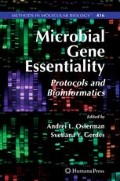Abstract
A method is described for generating conditional lethal mutations in essential genes in Escherichia coli. In this procedure, amber stop codons are introduced as “tagalong” mutations in the flanking DNA of a downstream antibiotic-resistance marker by lambda Red recombination. The marker is removed by expression of I-SceI homing endonuclease, leaving a markerless mutation. The mutants then depend upon expression of a suppressor transfer RNA (tRNA) for survival, which is expressed under control of the arabinose promoter on a high-copy-number plasmid.
Access this chapter
Tax calculation will be finalised at checkout
Purchases are for personal use only
References
Schmid, M. B., Kapur, N., Isaacson, D. R., Lindroos, P., and Sharpe, C. (1989) Genetic analysis of temperature-sensitive lethal mutants of Salmonella typhimurium. Genetics 123, 625–633.
Guzman, L. M., Belin, D., Carson, M. J., and Beckwith, J. (1995) Tight regulation, modulation, and high-level expression by vectors containing the arabinose PBAD promoter. J. Bacteriol. 177, 4121–4130.
Judson, N., and Mekalanos, J. J. (2000) TnAraOut, a transposon-based approach to identify and characterize essential bacterial genes. Nat. Biotechnol. 18, 740–745.
Forsyth, R. A., Haselbeck, R. J., Ohlsen, K. L., Yamamoto, R. T., Xu, H., Trawick, J. D., et al. (2002) A genome-wide strategy for the identification of essential genes in Staphylococcus aureus. Mol. Microbiol. 43, 1387–1400.
Ji, Y., Zhang, B., Van, S. F., Horn, W. P., Woodnutt, G., Burnham, M. K., and Rosenberg, M. (2001) Identification of critical staphylococcal genes using conditional phenotypes generated by antisense RNA. Science 293, 2266–2269.
Herring, C. D., Glasner, J. D., and Blattner, F. R. (2003) Gene replacement without selection: regulated suppression of amber mutations in Escherichia coli. Gene 311, 153–163.
Eggertsson, G., and Soll, D. (1988) Transfer ribonucleic acid-mediated suppression of termination codons in Escherichia coli. Microbiol. Rev. 52, 354–374.
Normanly, J., Kleina, L. G., Masson, J. M., Abelson, J., and Miller, J. H. (1990) Construction of Escherichia coli amber suppressor tRNA genes. III. Determination of tRNA specificity. J. Mol. Biol. 213, 719–726.
Herring, C. D., and Blattner, F. R. (2004) Global transcriptional effects of a suppressor tRNA and the inactivation of the regulator frmR. J. Bacteriol. 186, 6714–6720.
Steege, D. A., and Soll, D. G. (1979) Suppression. In: Goldberger, R. F., ed. Biological Regulation and Development, Vol. 1. New York: Plenum Press, pp. 433–485.
Edgar, R. S. (1966) Conditional lethals. In: Cairns, G., Stent, G. S., and Watson, J. D., eds. Phage and the Origins of Molecular Biology. Cold Spring Harbor, NY: Cold Spring Harbor Laboratory of Quantitative Biology, pp. 166–170.
Benzer, S., and Champe, S. P. (1962) A change from nonsense to sense in the genetic code. Proc. Natl. Acad. Sci. U.S.A. 48, 1114–1121.
Brenner, S., Stretton, A. O., and Kaplan, S. (1965) Genetic code: the “nonsense” triplets for chain termination and their suppression. Nature 206, 994–998.
Sarabhai, A. S., Stretton, A. O., Brenner, S., and Bolle, A. (1964) Co-linearity of the gene with the polypeptide chain. Nature 201, 13–17.
Engelhardt, D. L., Webster, R. E., Wilhelm, R. C., and Zinder, N. (1965) In vitro studies on the mechanism of suppression of a nonsense mutation. Proc. Natl. Acad. Sci. U.S.A. 54, 1791–1797.
Capecchi, M. R., and Gussin, G. N. (1965) Suppression in vitro: identification of a serine-sRNA as a “nonsense” suppressor. Science 149, 417–422.
Herring, C. D., and Blattner, F. R. (2004) Conditional lethal amber mutations in essential Escherichia coli genes. J. Bacteriol. 186, 2673–2681.
Neidhardt, F. C., Bloch, P. L., and Smith, D. F. (1974) Culture medium for enterobacteria. J. Bacteriol. 119, 736–747.
Posfai, G., Kolisnychenko, V., Bereczki, Z., and Blattner, F. R. (1999) Markerless gene replacement in Escherichia coli stimulated by a double-strand break in the chromosome. Nucleic Acids Res. 27, 4409–4415.
Bochner, B. R., Huang, H.-C., Schieven, G. L., and Ames, B. N. (1980) Positive selection for loss of tetracycline resistance. J. Bacteriol. 143, 926–933.
Murphy, K. C., and Campellone, K. G. (2003) Lambda Red-mediated recombinogenic engineering of enterohemorrhagic and enteropathogenic E. coli. BMC Mol. Biol. 4, 11.
Author information
Authors and Affiliations
Editor information
Editors and Affiliations
Rights and permissions
Copyright information
© 2008 Humana Press Inc., a part of Springer Science+Business Media, LLC
About this protocol
Cite this protocol
Herring, C.D. (2008). Introduction of Conditional Lethal Amber Mutations in Escherichia coli . In: Osterman, A.L., Gerdes, S.Y. (eds) Microbial Gene Essentiality: Protocols and Bioinformatics. Methods in Molecular Biology™, vol 416. Humana Press. https://doi.org/10.1007/978-1-59745-321-9_21
Download citation
DOI: https://doi.org/10.1007/978-1-59745-321-9_21
Publisher Name: Humana Press
Print ISBN: 978-1-58829-378-7
Online ISBN: 978-1-59745-321-9
eBook Packages: Springer Protocols

